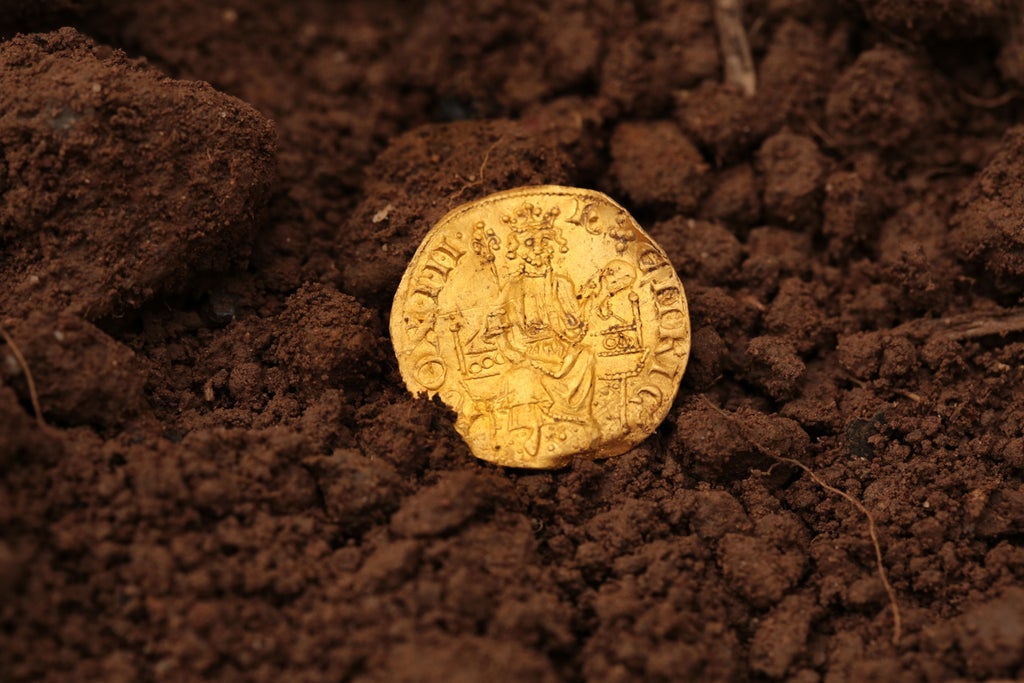
A rare gold coin depicting King Henry III which dates to the mid-13th century has sold for a record £648,000, months after being found by a metal detectorist in a field in England.
Prompted by his children, Michael Leigh-Mallory, 52, a father-of-two from Cullompton, Devon, had recently resumed his hobby when he made the chance discovery on 26 September last year.
Five months later, his find fetched £540,000 at London’s Spink and Son Auctioneers on Sunday, with the total reaching almost £650,000 once auction fees were included.
Gregory Edmund, senior numismatist at Spink, believes it is the most expensive single coin ever unearthed in Britain.
“The £648,000 is a huge record for a British medieval coin. It’s also the record for a single coin discovered in Britain,” he told The Independent.
Mr Edmund, who spotted the coin when Mr Leigh-Mallory posted a picture of it on Facebook, was quick to contact the metal detectorist.
“I immediately appreciated its significance,” he said, suggesting it was the most important coin discovered in the UK for 15 years.
However, it was not until the object was taken for further assessment at the British Museum, that its rarity was fully understood.
Only seven other examples of the Henry III gold penny, which was minted in 1257 by his goldsmith, William of Gloucester, are known to exist.
One side depicts the monarch, who reigned from 1216 to 1272, on a throne with a sceptre and orb, while the other has a long cross and rose mouldings.
Most of these pennies were melted down months after they were minted because the sudden flood of gold currency debased the price of the metal.
“This coin was a very short-lived thing. It was the king’s experiment at a time of emergency when he had to pay off his campaigners in Wales,” Mr Edmund explained.
Not long before the auction, Professor David Carpenter, a medieval historian at King’s College London, put forward a compelling theory about the penny found in farmland near Hemyock, Devon.
He said the likely owner was John de Hyden, the Lord of Hemyock Manor, who paid King Henry III 120 grams of gold to avoid jury service before later serving in the Welsh Campaign, in which more than 37,000 of these pennies were distributed.
Both specialists praised Mr Leigh-Mallory for his honesty about where he located the treasure, which allowed Mr Carpenter to pinpoint its probable owner.
Meanwhile, Mr Leigh-Mallory, who will split his earnings with the land owner, expressed his delight at his involvement. “I remain humbled and honoured to be linked with the discovery,” he said.
The 52-year-old added that the money will be spent on his children, who have developed a strong interest in history. “In fact, I really owe it to them for having found the coin in the first place, as they were my inspiration to go out prospecting.”
As well as the physical gold coin, Spink also sold an NFT of the object, with the £18,000 of proceeds donated to the Rodney Cook Memorial Fund, which supports cancer charities.
A King Henry III gold penny was sold for £526,000 in Dallas, Texas, last year, marginally less than the price realised in London on Sunday.
The anonymous buyer of the latest gold coin has pledged to loan it to a public institution, according to Spink. “It’s wonderful we have someone so philanthropic that they want the story to continue and to be for the public good,” Mr Edmund said.







